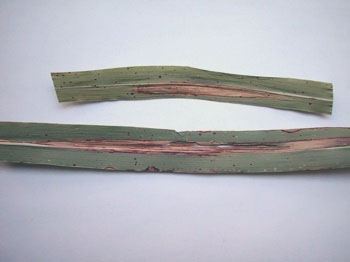Diseases
Helminthosporium turcicum Pass. - Northern Corn Leaf Blight (NCLB)
Systematic position.
Class Ascomycota, subclass Dothideomycetidae, order Pleosporales, family Pleomassariaceae, genus Helminthosporium.Biological group.
Facultative parasite.Morphology and biology.
Initial infection is most frequent on the lower leaves, looking like small gray-green lesions. As the disease develops, the lesions spread to all leafy structures. The lesions become cigar-shaped, brown, with light center and darker border. The length of spots is 3-7 cm and they are 0.4-1.0 cm wide. Lesions can coalesce when weather is favorable for disease development, and leaves dry out. During warm and moist weather the greenish black fungal sporulation forms on the infected leaf surface. Conidiophores are olive-green. The length of conidiophores is 150 microns, and the width is to 33 microns. They are multi-cellular, straight, or slightly curved. H. turcicum produces spindle-shaped multi-cellular olive conidia. The fungus causing NCLB over-winters as mycelia and chlamydospores on corn residues. In early summer new conidia are produced, carried by wind or rain to lower leaves of young corn plants. Infection occurs by germinating conidia, when free water is present on leaf surface for 6-18 hours and the temperature is between 18 and 27.C. Secondary infection spreads among fields by conidia formed on leaf tissues.Distribution.
The disease is spread throughout the west and south Ukraine, in Transcarpathia, Krasnodar Territory, Moscow Region, West Georgia, Altai, Siberia, Primorskii Territory. It has a very high severity in the Caucasus and west Georgia, where the yield losses can reach 40-70%. In Primorskii Territory 70% of leaves infected by H. turcicum during epidemic years can cause yield losses up to 40%.Ecology.
The optimum temperature for conidia germination is 23-30.C, optimum humidity is 90% and more.Economic significance.
When the disease demonstrates weak development the weight of ears decreases by 3.5%; with moderate development it decreases by 26.6%; with high development it decreases by 54.4%. To protect the corn from the disease the following measures are recommended: removal of infected corn residues; rotation of corn and sorghum in 1-2 years; treatment of grain by fungicides; use of disease-resistant hybrids of corn.Reference citations:
Erokhina S.A. 1990. Southern corn leaf blight. Kukuruza i sorgo, 3: 45-48. (In Russian)Gopalo N.M., Sokolov M.S., Chuprina V.P., Kobileva E.A. 1955. Damage of helminthosporium leaf lesions on corn, their epiphytotiology and protection of sowing. Agrokhimiya, 3: 101-119. (In Russian)
Kalashnikov K.Ya., Shapiro I.D. 1962. Pests and diseases of corn. Leningrad: Selkhozgiz. 189 p. (In Russian)
Makarova M.A., Annenkov B.G. 2001. The problem of Northern corn leaf blight in Russian Amur Region. V. 3. Khabarovsk: DVNIISKh. 38-45 p. (In Russian)
Sidorov A.A. 1990. Northern corn leaf blight in Moscow region. Zashchita rastenii, 3: 29. (In Russian)
© Levitin M.M.


